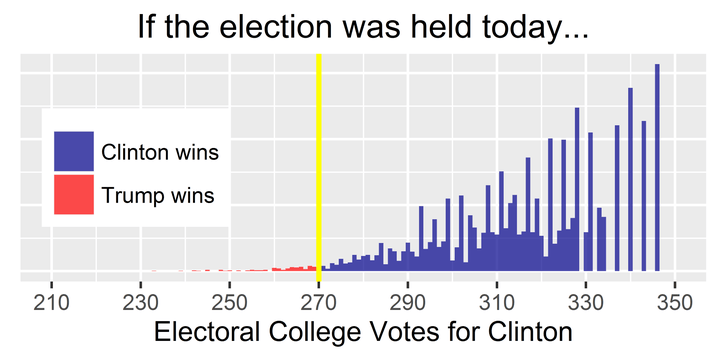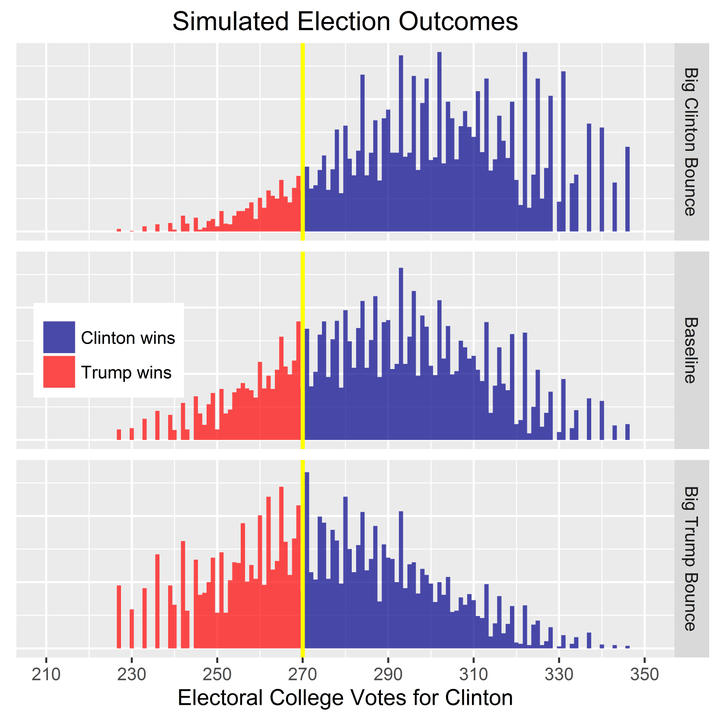
It’s political anxiety season in America! In just the last two weeks, Hillary Clinton soared from even odds to the prohibitive favorite in prominent election forecasts. Yet several polls continue to show a tight race, and many argue that Donald Trump has a plausible path to the White House. And then there’s the polling debacle that was Brexit. Every day brings new polls and new opportunities to envision the coming apocalypse of November 8. What does it all mean!?!? Before pulling your hair out, take a moment for some data therapy. Sorry Republican friends, but you’ll want to sit down for this session.
Let’s start with what we actually know about the election at this point. For all the unpredictability of campaign season, we know quite a lot:
The candidate who wins 270 Electoral College votes gets to live in the White House.
As usual, nearly all states look like foregone conclusions, and, short of a landslide, six to ten states will determine the outcome.
Clinton has a yuuuge advantage at the outset because the Democrats lock up more populous states (think California vs Alaska). She starts with about 227 Electoral College votes in her pocket. Trump can bank on only 191.
Based on early campaign activity, public statements from both parties, and recent polls, there are probably nine states in play: Colorado, Florida, Iowa, Nevada, New Hampshire, North Carolina, Ohio, Pennsylvania, and Virginia.
Clinton only needs to win 43, or about 36 percent, of the 120 Electoral College votes still up for grabs.
Then there are the polls. Less than one week into the general election, and we’re inundated with polling data, especially out of the battleground states. So what do the data tell us?
Here I started with Clinton’s forecasted win percentage in each of the nine battleground states according to FiveThirtyEight’s “now-cast model.” The model uses polling data to predict Clinton’s probability of winning a state if the election were held today. For instance, the model gives Hillary a 52% chance of winning Ohio’s eighteen Electoral College votes. Of course, the prediction is, well, probabilistic. Those eighteen votes ought to go in the Trump column about half of the time. So I used the predicted probabilities for each state to simulate 10,000 elections. This produced a distribution of Hillary Clinton’s Electoral College total, where taller bars signal more common outcomes.

It doesn’t take a statistician to see that the Donald would be in trouble if we scheduled elections for August 4. Hillary Clinton clears the 270-vote hurdle in a whopping 98 percent of the simulations. Of course, we hold elections in November. Just ask John McCain, Ross Perot, Al Gore, and Michael Dukakis about the value of a mid-campaign lead in the polls. Hillary Clinton is riding a sizable “convention bounce,” but polls change.
So let’s walk back to more solid ground. Start by assuming that Clinton and Trump will be tied on election day in five swing states (Pr(Clinton wins) = 0.5). Virginia, Colorado, and Pennsylvania are clearly leaning blue (give them 0.55, 0.55, and 0.6 respectively). North Carolina leans red (0.4). Take these probabilities and simulate another 10,000 elections. These outcomes form the baseline distribution below. Of course even safe assumptions can be wrong. So let’s see what happens if Clinton gets another big bounce in the polls and her probability of winning goes up by 0.1 in every swing state. Simulate another 10,000 elections. Then, because the Clintons are no strangers to unforced errors, let’s give Trump that same bounce and simulate 10,000 more elections.

Sorry Trump fans, but the math doesn’t help you much. Hillary Clinton takes the White House 77 percent of the time in the baseline model. If Clinton gets another bump, her chance of winning goes up to 91 percent. Both are better for Trump fans than 98 percent, but the parameters of the baseline model are pretty conservative. And even if we assume that Trump gets a giant bounce by November, Hillary’s chance of winning still sits at 60 percent.
The bottom line is that this is Clinton’s election to lose. Could she still falter? Definitely. Just ask Al Gore and John Kerry about that head start on the electoral college map. Is it likely? Not at all.

